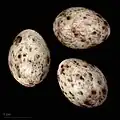| Tree pipit | |
|---|---|
.jpg.webp) | |
| Scientific classification | |
| Domain: | Eukaryota |
| Kingdom: | Animalia |
| Phylum: | Chordata |
| Class: | Aves |
| Order: | Passeriformes |
| Family: | Motacillidae |
| Genus: | Anthus |
| Species: | A. trivialis |
| Binomial name | |
| Anthus trivialis | |
 | |
| Range of A. trivialis Breeding Non-breeding Passage | |
| Synonyms | |
| |

The tree pipit (Anthus trivialis) is a small passerine bird which breeds across most of Europe and the Palearctic as far East as the East Siberian Mountains. It is a long-distance migrant moving in winter to Africa and southern Asia. The scientific name is from Latin: anthus is the name for a small bird of grasslands, and the specific trivialis means "common".
The breeding habitat is open woodland and scrub. The nest is placed on the ground, with usually 4–6 eggs being laid. This species is insectivorous, like its relatives, but will also take seeds.
Taxonomy
The tree pipit was formally described by the Swedish naturalist Carl Linnaeus in 1758 in the tenth edition of his Systema Naturae under the binomial name Alauda trivialis. Linnaeus noted that the species occurred in Sweden.[2] The specific epithet trivialis is Latin meaning "common" or "ordinary" from Latin trivium meaning "public street".[3] The tree pipit is now placed in the genus Anthus that was introduced in 1805 by the German naturalist Johann Matthäus Bechstein.[4][5]
Two subspecies are recognised:[5]
- A. t. trivialis (Linnaeus, 1758) – breeds across Europe to southwest Siberia, north Iran and Turkey, east Kazakhstan, southcentral Siberia, Mongolia and northwest China; winters in India and Africa. Includes proposed subspecies sibiricus.
- A. t. haringtoni Witherby, 1917 – breeds in northwest Himalayas; winters in central India
Description
This is a small pipit, which resembles meadow pipit. It is an undistinguished-looking species, streaked brown above and with black markings on a white belly and buff breast below. It can be distinguished from the slightly smaller meadow pipit by its heavier bill and greater contrast between its buff breast and white belly. Tree pipits more readily perch in trees.
The call is a strong spek, unlike the weak call of its relative. The song flight is unmistakable. The bird rises a short distance up from a tree, and then parachutes down on stiff wings, the song becoming more drawn out towards the end.
Life cycle
- mid-September to mid-April: lives in sub Saharan Africa
- mid April to beginning of May: migrates and arrives in countries such as the United Kingdom
- beginning of May to August: breeding season, two broods
- August to mid September: flies back to Saharan Africas
Distribution and habitat
The tree pipit breeds in habitats with a wooded component, including lowland heath and coppice. It is found mostly in open woodland on the boundary with moorland, or open structured oak woodland – therefore heavy thinning is required to produce a gappy character. It prefers low canopy medium-sized trees, where there is low-growing scrub and bramble less than 2 metres high, so that horizontal visibility is relatively high. It likes a mosaic of grass and bracken, but not very grazed short turf, so light to moderate grazing is preferred.[6]
Behaviour
Breeding
Tree pipits nest on the ground amongst grass or heather tussocks. The nest is built by the female. The clutch of 4 to 6 eggs is incubated by the female. The eggs hatch after 12–14 days. The chicks are fed by both parents and leave the nest after 12–14 days. The nests are sometimes parasitized by the common cuckoo (Cuculus canorus).[6]
Feeding
Tree pipits mainly eat invertebrates, typically insects but will also eat some plant material. They mostly forage on the ground.[6]
Gallery
 In India
In India Eggs, Collection Museum Wiesbaden, Germany
Eggs, Collection Museum Wiesbaden, Germany-1.jpg.webp) In flight
In flightat_Sindhrot_near_Vadodara%252C_Gujrat_Pix_243.jpg.webp) In Gujarat, India
In Gujarat, India%252C_Kappertzvenn_bei_M%C3%BCrringen%252C_Ostbelgien_(3939066668).jpg.webp) In Belgium
In Belgium Historical illustration from 1907-1908 by Henrik Grönvold
Historical illustration from 1907-1908 by Henrik Grönvold Tree Pipit wintering in Anamalai Hills, India
Tree Pipit wintering in Anamalai Hills, India Cuculus canorus canorus in a clutch of Anthus trivialis - MHNT
Cuculus canorus canorus in a clutch of Anthus trivialis - MHNT Anthus trivialis trivialis - MHNT
Anthus trivialis trivialis - MHNT
References
- ↑ BirdLife International (2018). "Anthus trivialis". IUCN Red List of Threatened Species. 2018: e.T22718546A131985523. doi:10.2305/IUCN.UK.2018-2.RLTS.T22718546A131985523.en. Retrieved 12 November 2021.
- ↑ Linnaeus, Carl (1758). Systema Naturae per regna tria naturae, secundum classes, ordines, genera, species, cum characteribus, differentiis, synonymis, locis (in Latin). Vol. 1 (10th ed.). Holmiae (Stockholm): Laurentii Salvii. p. 166.
- ↑ Jobling, James A. (2010). The Helm Dictionary of Scientific Bird Names. London: Christopher Helm. p. 391. ISBN 978-1-4081-2501-4.
- ↑ Bechstein, Johann Matthäus (1805). Gemeinnützige Naturgeschichte Deutschlands nach allen drey Reichen (in German). Vol. 2 (2nd ed.). Leipzig: Bey Siegfried Lebrecht Crusiu. pp. 247, 302 Note.
- 1 2 Gill, Frank; Donsker, David; Rasmussen, Pamela, eds. (January 2021). "Waxbills, parrotfinches, munias, whydahs, Olive Warbler, accentors, pipits". IOC World Bird List Version 11.1. International Ornithologists' Union. Retrieved 9 June 2021.
- 1 2 3 Tyler, Stephanie J. (2004). "Family Motacillidae (Pipits and Wagtails)". In del Hoyo, J.; Elliott, A.; Christie, D.A. (eds.). Handbook of the Birds of the World. Vol. 9: Cotingas to Pipits and Wagtails. Barcelona, Spain: Lynx Edicions. pp. 686-786 [765] ]. ISBN 978-84-87334-69-6.
